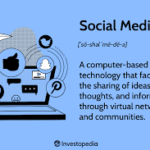In today’s digital age, both social media and mass media play pivotal roles in the field of communication. This article explores the connection between these two mediums and discusses the influence of social media on mass media in the realm of information dissemination.

- Definition and Characteristics:
- Social Media: It refers to online platforms and websites that allow users to create, share, and interact with content. Examples include Facebook, Twitter, Instagram, and YouTube. Social media thrives on user-generated content and fosters engagement among individuals.
- Mass Media: It encompasses traditional forms of media, such as newspapers, television, radio, and magazines. Mass media channels are generally operated by organizations and deliver information to a large audience.
- Interplay Between Social Media and Mass Media:
- Complementary Relationship: Social media and mass media often complement each other. Mass media outlets use social media platforms to extend their reach, promote their content, and engage with their audience. Conversely, social media users rely on mass media as a source of news and information, which they then share and discuss on social media platforms.
- Influence of Social Media on Mass Media:
- Speed and Real-Time Reporting: Social media platforms enable instant sharing of news and events, often faster than traditional mass media channels. This prompts mass media outlets to adapt and incorporate social media in their reporting to maintain timeliness and relevance.
- User-Generated Content: Social media encourages individuals to actively participate in content creation. This has influenced mass media to incorporate user-generated content, such as eyewitness videos and photos, into their news coverage.
- Audience Engagement: Social media provides a platform for audience feedback and interaction. Mass media outlets have embraced this aspect by encouraging viewer participation through polls, comments, and sharing options, thereby enhancing engagement and building a community around their content.
- Challenges and Considerations:
- Credibility and Verification: The rise of social media has led to the spread of misinformation and fake news. Mass media faces the challenge of verifying information obtained from social media sources to maintain their credibility and trustworthiness.
- Fragmented Audiences: Social media has contributed to the fragmentation of audiences, as individuals can customize their content consumption. Mass media needs to adapt and find ways to cater to these diverse preferences to remain relevant.
Social media and mass media are interconnected in the realm of communication. While social media has impacted mass media by influencing reporting speed, incorporating user-generated content, and fostering audience engagement, mass media continues to serve as a trusted source of information and contributes to the credibility and verification of news. As both mediums evolve, their relationship will continue to shape the landscape of media communication.












































